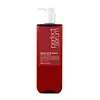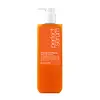What's inside
What's inside
 Key Ingredients
Key Ingredients

 Benefits
Benefits

 Concerns
Concerns

 Ingredients Side-by-side
Ingredients Side-by-side

Water
Skin ConditioningSodium Laureth Sulfate
CleansingGlycerin
HumectantDisodium Laureth Sulfosuccinate
CleansingCocamidopropyl Betaine
CleansingLaureth-6 Carboxylic Acid
CleansingCaprylyl/Capryl Glucoside
CleansingParfum
MaskingPolyquaternium-10
Sodium Chloride
MaskingDimethiconol
EmollientSodium Lauroyl Sarcosinate
CleansingTea-Dodecylbenzenesulfonate
CleansingSodium Benzoate
MaskingCaprylyl Glycol
EmollientPhenoxyethanol
PreservativeCitric Acid
BufferingSodium Salicylate
PreservativeSodium Citrate
BufferingHexanediol
SolventPolyquaternium-7
Tetrasodium EDTA
PEG-150 Pentaerythrityl Tetrastearate
EmulsifyingBenzyl Salicylate
PerfumingPPG-2 Hydroxyethyl Cocamide
EmulsifyingDisodium EDTA
Limonene
PerfumingArgania Spinosa Kernel Oil
EmollientSimmondsia Chinensis Seed Oil
EmollientCocos Nucifera Oil
MaskingAbies Alba Seed Oil
AntimicrobialOlea Europaea Fruit Oil
MaskingCamellia Seed Oil
Sclerocarya Birrea Seed Oil
HumectantCoco-Caprylate/Caprate
EmollientAlcohol Denat.
AntimicrobialGlycolipids
Skin ConditioningWater, Sodium Laureth Sulfate, Glycerin, Disodium Laureth Sulfosuccinate, Cocamidopropyl Betaine, Laureth-6 Carboxylic Acid, Caprylyl/Capryl Glucoside, Parfum, Polyquaternium-10, Sodium Chloride, Dimethiconol, Sodium Lauroyl Sarcosinate, Tea-Dodecylbenzenesulfonate, Sodium Benzoate, Caprylyl Glycol, Phenoxyethanol, Citric Acid, Sodium Salicylate, Sodium Citrate, Hexanediol, Polyquaternium-7, Tetrasodium EDTA, PEG-150 Pentaerythrityl Tetrastearate, Benzyl Salicylate, PPG-2 Hydroxyethyl Cocamide, Disodium EDTA, Limonene, Argania Spinosa Kernel Oil, Simmondsia Chinensis Seed Oil, Cocos Nucifera Oil, Abies Alba Seed Oil, Olea Europaea Fruit Oil, Camellia Seed Oil, Sclerocarya Birrea Seed Oil, Coco-Caprylate/Caprate, Alcohol Denat., Glycolipids
Water
Skin ConditioningGlycerin
HumectantDipropylene Glycol
HumectantCetyl Alcohol
EmollientStearyl Alcohol
EmollientDimethicone
EmollientBehentrimonium Chloride
PreservativeIsopropyl Alcohol
SolventParfum
MaskingHydroxyethylcellulose
Emulsion StabilisingEthylhexylglycerin
Skin ConditioningDisodium EDTA
Hc Yellow No. 4
CI 19140
Cosmetic ColorantTocopherol
AntioxidantArgania Spinosa Kernel Oil
EmollientAbies Alba Seed Oil
AntimicrobialOlea Europaea Fruit Oil
MaskingSimmondsia Chinensis Seed Oil
EmollientCamellia Seed Oil
Cocos Nucifera Oil
MaskingCI 17200
Cosmetic ColorantBlue 1 Lake
Cosmetic ColorantCoco-Caprylate/Caprate
EmollientSclerocarya Birrea Seed Oil
HumectantGlycolipids
Skin ConditioningWater, Glycerin, Dipropylene Glycol, Cetyl Alcohol, Stearyl Alcohol, Dimethicone, Behentrimonium Chloride, Isopropyl Alcohol, Parfum, Hydroxyethylcellulose, Ethylhexylglycerin, Disodium EDTA, Hc Yellow No. 4, CI 19140, Tocopherol, Argania Spinosa Kernel Oil, Abies Alba Seed Oil, Olea Europaea Fruit Oil, Simmondsia Chinensis Seed Oil, Camellia Seed Oil, Cocos Nucifera Oil, CI 17200, Blue 1 Lake, Coco-Caprylate/Caprate, Sclerocarya Birrea Seed Oil, Glycolipids
Ingredients Explained
These ingredients are found in both products.
Ingredients higher up in an ingredient list are typically present in a larger amount.
Abies Alba Seed Oil is an antioxidant and is an oil.
You may know this ingredient as argan oil. Argan Oil has antioxidant, hydrating, and soothing properties.
Studies have shown argan oil can help fight again radical damage from the sun. This makes it effective at preventing hyperpigmentation.
Large amounts of vitamin E found in argan oil helps the skin retain water. Argan oil also contains fatty acids such as linoleic acid, oleic acid, and palmitic acid. It is also a good source of lipids.
Another benefit of argan oil is skin-soothing. It can help reduce inflammation-related skin symptoms.
Argan Oil is effective at regulating sebum production in pores. This can make it effective at treating hormonal acne.
Traditionally, argan oil was used for its antibacterial and antifungal properties. However, argan oil contains fatty acids that may make it not fungal-acne safe.
Argan Trees are native to Morocco.
Learn more about Argania Spinosa Kernel OilCamellia Seed Oil is an oil and isn't fungal acne safe.
Coco-Caprylate/Caprate is created from fatty coconut alcohol, caprylic acid, and capric acid.
It is a lightweight emollient. Emollients create a thin barrier on the skin to trap moisture in. This helps keep your skin hydrated and soft.
Once applied, Coco-Caprylate/Caprate is absorbed quickly and leaves a silky feel.
Coco-Caprylate/Caprate may not be fungal acne safe.
Learn more about Coco-Caprylate/CaprateCocos Nucifera Oil is obtained from the kernels of the coconut fruit. In other words, this is coconut oil.
Coconut Oil is rich in fatty acids with lauric acid making up the majority of these. It also contains linoleic acid. Due to this high fatty acid content, coconut oil helps trap moisture and soften skin.
Despite being antibacterial, coconut oil may not be great for acne-prone skin. It is comedogenic and may clog pores. This ingredient may not be safe for malassezia or fungal acne.
Note: Coconut Oil should not replace your sunscreen for UV protection. Studies show it only blocks about 20% of UV.
This oil is non-volatile and has a light scent.
The term 'fragrance' is not regulated in many countries. In many cases, it is up to the brand to define this term. For instance, many brands choose to label themselves as "fragrance-free" because they are not using synthetic fragrances. However, their products may still contain ingredients such as essential oils that are considered a fragrance.
Learn more about Cocos Nucifera OilDisodium EDTA plays a role in making products more stable by aiding other preservatives.
It is a chelating agent, meaning it neutralizes metal ions that may be found in a product.
Disodium EDTA is a salt of edetic acid and is found to be safe in cosmetic ingredients.
Learn more about Disodium EDTAGlycerin is already naturally found in your skin. It helps moisturize and protect your skin.
A study from 2016 found glycerin to be more effective as a humectant than AHAs and hyaluronic acid.
As a humectant, it helps the skin stay hydrated by pulling moisture to your skin. The low molecular weight of glycerin allows it to pull moisture into the deeper layers of your skin.
Hydrated skin improves your skin barrier; Your skin barrier helps protect against irritants and bacteria.
Glycerin has also been found to have antimicrobial and antiviral properties. Due to these properties, glycerin is often used in wound and burn treatments.
In cosmetics, glycerin is usually derived from plants such as soybean or palm. However, it can also be sourced from animals, such as tallow or animal fat.
This ingredient is organic, colorless, odorless, and non-toxic.
Glycerin is the name for this ingredient in American English. British English uses Glycerol/Glycerine.
Learn more about GlycerinGlycolipids are natural, sustainable biosurfactants. They are both surfactants (cleansing agents) and emollients.
Made from lipids and sugars, in-vitro studies show glycolipids are a gentle alternative to conventional surfactants. They also possess foaming properties to give cleaning products a nice texture.
One manufacturer study found their glycolipid also demonstrated sebum reduction and helped reduced oiliness after four weeks. This means it can also be great for scalp care.
Learn more about GlycolipidsOlea Europaea Fruit Oil is the fixed oil obtained from the ripe fruit of the Olive. In other words - olive oil.
The primary contents of olive oil are glycerides of the fatty acids linoleic, oleic and palmitic.
Olive oil also contains antioxidants such as Vitamin E. Antioxidants may help reduce signs of aging by fighting unstable free-radical molecules. It also contains Vitamins A (retinol), D, and K.
The squalene in olive oil makes it a great emollient. Emollients help soothe and soften your skin by trapping moisture in. This makes olive oil a great skin moisturizer.
Studies show olive oil to have antibacterial and antifungal properties in low concentrations. Another study found olive oil irritated sensitive oily skin. We always recommend speaking with a professional about using this ingredient in your routine.
Due to the fatty acid content, this ingredient may not be fungal-acne safe.
Learn more about Olea Europaea Fruit OilParfum is a catch-all term for an ingredient or more that is used to give a scent to products.
Also called "fragrance", this ingredient can be a blend of hundreds of chemicals or plant oils. This means every product with "fragrance" or "parfum" in the ingredients list is a different mixture.
For instance, Habanolide is a proprietary trade name for a specific aroma chemical. When used as a fragrance ingredient in cosmetics, most aroma chemicals fall under the broad labeling category of “FRAGRANCE” or “PARFUM” according to EU and US regulations.
The term 'parfum' or 'fragrance' is not regulated in many countries. In many cases, it is up to the brand to define this term.
For instance, many brands choose to label themselves as "fragrance-free" because they are not using synthetic fragrances. However, their products may still contain ingredients such as essential oils that are considered a fragrance by INCI standards.
One example is Calendula flower extract. Calendula is an essential oil that still imparts a scent or 'fragrance'.
Depending on the blend, the ingredients in the mixture can cause allergies and sensitivities on the skin. Some ingredients that are known EU allergens include linalool and citronellol.
Parfum can also be used to mask or cover an unpleasant scent.
The bottom line is: not all fragrances/parfum/ingredients are created equally. If you are worried about fragrances, we recommend taking a closer look at an ingredient. And of course, we always recommend speaking with a professional.
Learn more about ParfumSclerocarya Birrea Seed Oil is the oil expressed from the seeds of the Marula plant. In South Africa, Marula is called "an elephant's favorite treat".
Marula seed oil is a non-fragrant oil. It is rich in fatty acids, such as oleic, linoleic, palmitic, stearic, and more. These fatty acids help hydrate the skin.
Other components of marula seed oil include vitamin E and antioxidants such as flavonoids.
Due to the fatty acid content, this ingredient may not be fungal-acne safe.
Learn more about Sclerocarya Birrea Seed OilThis oil comes from the seeds of the desert shrub called Jojoba. It is more commonly known as jojoba oil, a non-comedogenic oil.
Jojoba oil does not contain fragrance and has many fatty-acids, making it a great soothing ingredient.
It also contains Vitamin E, a great moisturizing ingredient. Vitamin E is also an antioxidant and protects your skin against oxidative damage.
This ingredient humectant properties, meaning it helps draw moisture from the air. This helps keep your skin hydrated.
While jojoba has antibacterial properties, it is only able to kill some strains of bacteria.
Studies also show it helps in wound healing. In fact, Indigenous cultures have used jojoba as a moisturizer and to help treat burns for centuries.
Fun fact: Jojoba oil similar to natural human skin sebum, so it has a great effect on dry skin. It is also promising with helping to regulate sebum production.
Due to its fatty acid content, Jojoba oil may not be fungal acne safe. We recommend speaking with a professional if you have any concerns.
Learn more about Simmondsia Chinensis Seed OilWater. It's the most common cosmetic ingredient of all. You'll usually see it at the top of ingredient lists, meaning that it makes up the largest part of the product.
So why is it so popular? Water most often acts as a solvent - this means that it helps dissolve other ingredients into the formulation.
You'll also recognize water as that liquid we all need to stay alive. If you see this, drink a glass of water. Stay hydrated!
Learn more about Water